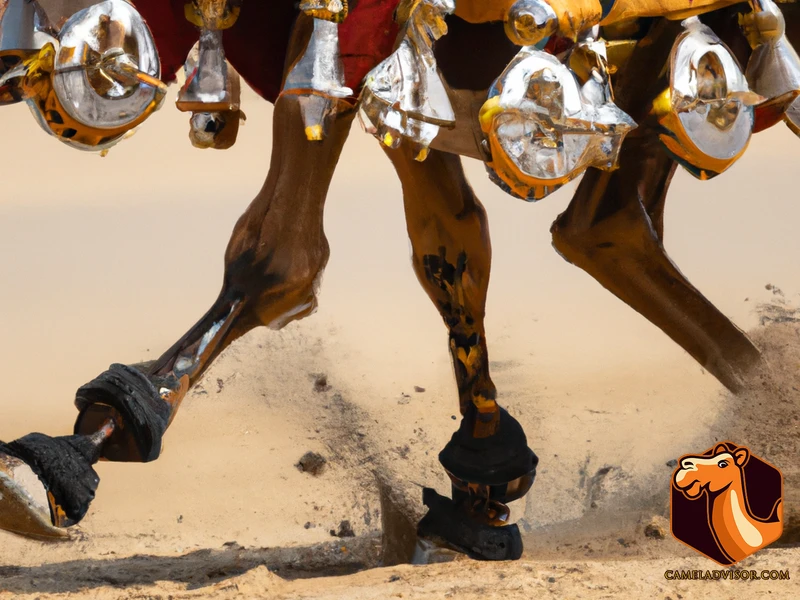Contents
- Introduction
- The Jockeys’ Outfits
- The Saddles
- The Blinkers
- The Leg Wraps
- The Nose Clips and Ear Plugs
- The Whips
- The Training Equipment
- Conclusion
-
Frequently Asked Questions
- What is camel racing?
- Why do jockeys wear certain gear when racing camels?
- What are kanduras?
- What are safety jackets used for?
- Why do jockeys wear caps?
- What are traditional camel saddles made of?
- Why are some saddles lighter than others?
- What are blinkers used for?
- What are leg wraps used for?
- What are nose clips and ear plugs used for?
- References
Introduction
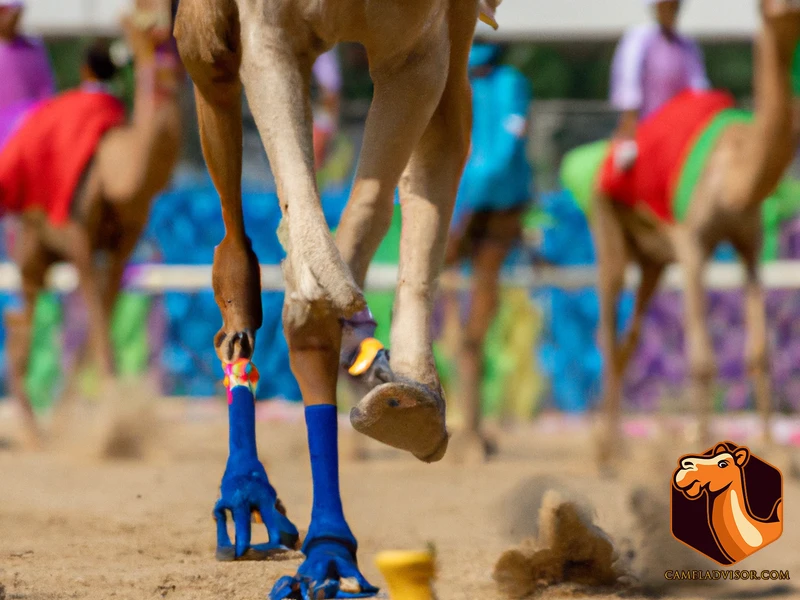
The world of camel racing is a fascinating one, with a rich history and cultural significance. But what truly sets this sport apart is the revolutionary gear used by professional camel racing jockeys. From traditional saddles to modern lightweight designs, and from blinkers to leg wraps, these gears are essential to the sport and to the safety of both camels and jockeys. In this article, we’ll take a closer look at the various gears used in professional camel racing, and explore their unique features and benefits. So strap in, and get ready to be amazed by the ingenuity and innovation of camel racing gear!
The Fascinating World of Camel Racing
As an assistant helping to write about “Revolutionary Gears Used in Professional Camel Racing,” it’s important to acknowledge the fascinating world of camel racing. The sport, which involves racing camels at high speeds, is gaining popularity in many countries around the world.
Camel racing is often seen as a traditional activity that has been part of Middle Eastern culture for centuries. However, it has now become a modern and high-tech sport. With the emergence of modern technology, camel racing has transformed into a more exciting and thrilling sport.
Modern camel racing has become a trend, and it has affected the way jockeys and trainers approach the sport. From specialized saddles to high-tech equipment and gear, the sport has changed significantly over the years.
There are many essential camel racing tools and accessories that are used in the sport to ensure that both the jockey and camel are safe and comfortable throughout the race. This includes specialized saddles, jockeys’ gear, clothing, and other accessories such as nose clips and earplugs.
Camel racing is a sport that requires a high level of training and expertise. The role of trainers in the sport cannot be overstated. They are responsible for ensuring that the camels are properly trained, and that the jockeys have the necessary skill and experience to ride them.
To keep the camels fit and healthy, trainers use specialized equipment such as mechanical camels and treadmills. These machines simulate the movements of a real camel, allowing trainers to train their camels effectively.
As technology continues to advance, so does the equipment and gear used in camel racing. It’s fascinating to see how the sport has evolved over the years and how it continues to grow in popularity.
For more information on the different types of camel racing equipment and a comparison between traditional and modern gear, you can check out this article.
Why Gear Matters
In the world of camel racing, having the right gear is essential to the success of both the jockey and the camel. The gear used in camel racing is designed to ensure the safety and well-being of both the jockey and the camel, as well as to improve the performance of the camel during the race. There are several different pieces of gear that are used in camel racing, each with its own unique purpose and design.
One of the most important pieces of gear worn by the jockey is the kandura, a long white robe that helps to keep the jockey cool in hot weather. In addition to the kandura, jockeys also wear safety jackets and caps to protect them in case of a fall.
The saddles used in camel racing have also evolved over time. Traditional camel saddles were made of heavy leather and were not designed with the jockey’s comfort in mind. However, modern lightweight saddles are now available, which allow for greater maneuverability and speed during the race. Specialized saddles are also available for different types of races, such as long-distance races and sprint races.
To help keep the camel focused and prevent distractions during the race, blinkers are used. These are designed to limit the camel’s field of vision, so that it can focus solely on the race ahead.
In addition, leg wraps are used to provide support and protect the legs of the camel during the race. These can be made of a variety of materials, including neoprene and cotton.
To keep the camel calm and focused during the race, nose clips and ear plugs are also used. The nose clip helps to regulate the camel’s breathing, while the ear plugs help to block out distractions and noise.
Finally, jockeys use whips during the race to provide direction and encouragement to the camel. While the use of whips in camel racing has been controversial in the past, many races now require jockeys to use soft, padded whips to minimize the risk of injury to the camel.
The gear used in camel racing is essential to the success of both the jockey and the camel. Modern trends in camel racing gear are focused on improving the safety and well-being of the animals, as well as on enhancing their performance during the race.
The Jockeys’ Outfits
As the camels hit the race track, the jockeys sitting atop them perfectly exhibit the essence of camel racing. The jockeys’ outfits are an important aspect of their performance in a race. From the traditional kanduras to the modern safety jackets, each item of clothing serves a specific purpose. In this section, we will take a closer look at the jockeys’ gear, which is an integral part of the overall camel racing equipment. If you want to learn more about camel racing equipment, you can check out traditional camel racing equipment or read on further.
The Kanduras
In professional camel racing, the jockeys’ gear plays a crucial role in their performance. Among the key elements of their attire are the
kanduras, a traditional garment worn in Arab countries. The kanduras are loose, ankle-length robes made of lightweight fabric such as cotton or linen, which helps keep the jockeys cool in the scorching heat of the desert.
These robes can come in different colors, with white being the most commonly used. They are typically adorned with logos, patterns, and sponsors’ names. In addition to the aesthetic aspect, these decorations also serve a functional purpose. For example, they can indicate which team the jockey represents or help the riders identify one another during the race.
The kanduras are usually tailored to fit the jockeys’ bodies, and they have long sleeves to protect their arms from sunburns. Underneath the kanduras, the jockeys typically wear compression gear to help regulate their body temperature and improve their blood circulation.
The kanduras are a quintessential element of the jockeys’ gear in camel racing. They are not just a cultural symbol but an essential element of their clothing, allowing jockeys to perform at their best during competitions.
To read more about the equipment and accessories used in camel racing, check out our article on essential camel racing tools and accessories.
The Safety Jackets
Safety jackets are an important part of the gear used in professional camel racing. These jackets are specially designed to protect jockeys from injuries in case of an accident during the race. The jackets are made of lightweight material and are padded with shock-absorbing foam to protect the jockeys from the impact of a fall or collision.
The safety jackets are a relatively new addition to the sport of camel racing due to the increasing concern for the safety of the jockeys. In the past, jockeys used to wear only traditional clothing, such as kanduras, and did not have any protective gear. However, with the emergence of high-tech camel racing, safety measures have become a top priority.
There are various types of safety jackets available in the market, including those made of synthetic materials and those made of leather. Some jackets are designed to fit over the kanduras, while others are worn underneath. Some jackets also come with additional features such as air vents, adjustable straps, and reflective tape for better visibility during night races.
It is important to note that while wearing a safety jacket is mandatory for all jockeys, it does not guarantee complete safety. Accidents can still happen, and jockeys need to be careful while riding at high speeds. Proper training and experience are also essential for jockeys to minimize the risk of accidents and injuries.
Safety jackets are an important part of the gear used in professional camel racing. They provide much-needed protection to jockeys and help ensure their safety during races. To learn more about the gear used in camel racing, check out our article on jockeys’ gear and clothing.
The Caps
Caps are an essential part of the jockey’s attire. In camel racing, jockeys usually wear white caps to ensure that they are easily visible to judges during the race. Caps also act as a protective gear for the riders’ heads. As camel racing is a high-speed sport, it is imperative to have proper protective headgear.
Traditionally, jockeys used to wear turbans instead of caps, but as time passed, caps became more popular. Caps used in camel racing are lightweight and designed to fit snugly onto the jockey’s head. The cap’s construction involves durable material like leather or synthetic fabric, which guarantees protection to the riders’ head in case of fall.
Caps usually have chin straps that keep them securely in place during the race, making them comfortable for the jockeys to wear without the fear of it falling off during races. Some jockeys even prefer to wear a soft padding beneath their caps for added protection and comfort.
The use of proper caps also depends on the weather, for instance, during summers, jockeys can opt for caps with a breathable mesh that helps in cooling the jockey’s head, whereas during winters, jockeys can opt for caps that have warm lining to keep them warm during the race.
Caps are a crucial part of a jockey’s gear in camel racing that provides protection and comfort to the riders. A snugly fitted and adequately cushioned cap reduces the risk of any injuries during the race. With the emergence of high tech in the camel racing industry and the importance of trainers, equipment camel racing, the gear used in camel racing continues to evolve, with caps playing a vital role in ensuring the safety of jockeys.
The Saddles
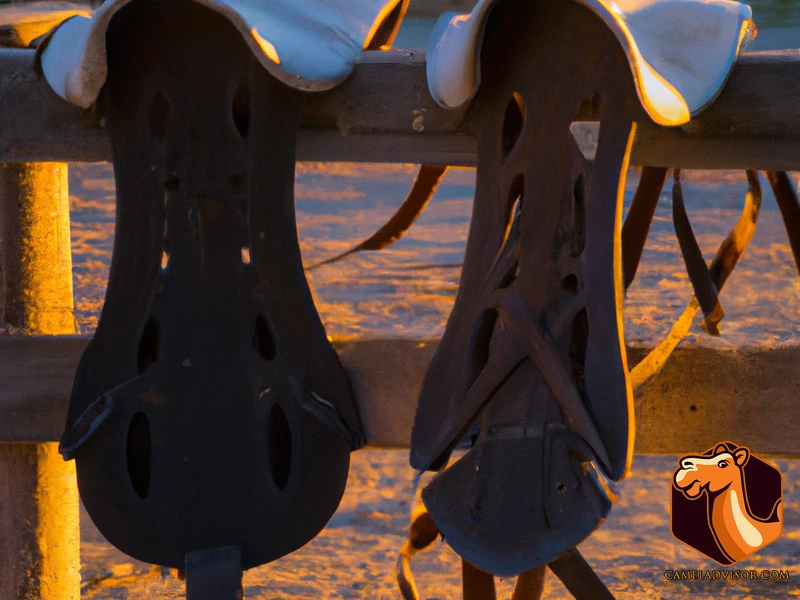
When it comes to camel racing, one of the most essential pieces of equipment used are the saddles. These are specially designed to fit the unique shape of a camel’s hump and allow the jockey to maintain balance while riding at high speeds. In the past, traditional camel saddles were the only option, but as technology has advanced, newer and more lightweight saddles have emerged. Let’s take a closer look at the saddles used in professional camel racing. To fully understand the significance and development of gear in camel racing, it’s worth looking into the emergence of high-tech camel racing and the importance of trainers’ equipment in this sport. Additionally, we’ve already discussed the clothing gear worn by the jockeys.
The Traditional Camel Saddles
Camel saddles have been an integral part of camel racing for centuries. The traditional camel saddles are made of leather and consist of a wooden frame that is covered with a layer of sheepskin to provide comfort to the animal. The saddle is padded with soft cushions, and a cloth is used to secure it around the camel’s belly.
The traditional camel saddles are heavy and can weigh up to 80 kilograms. The weight of the saddle is a disadvantage in camel racing as it slows down the animal. The saddle also causes discomfort to the camel, making it difficult for the jockey to control the animal.
Despite these drawbacks, some traditionalists still prefer using these saddles over their modern lightweight counterparts. Camels that are trained to race with these saddles find it difficult to adjust to the modern ones. Additionally, some believe that the traditional saddles are better for the camel’s back as they provide better support.
While traditional camel saddles have a certain charm and history attached to them, they are not the most practical gear for professional camel racing. The sport demands speed and precision, and the weight and discomfort caused by the saddle can hinder the animal’s performance. That being said, it is also important to preserve the cultural practices and history of camel racing, which includes the use of traditional saddles.
The Modern Lightweight Saddles
Modern lightweight saddles are a game-changer in the world of camel racing. They are designed with advanced materials and technology to increase the speed and agility of the camel while ensuring the safety and comfort of the jockey. Here are some of the features of these revolutionary saddles:
- Ergonomic Design: Modern lightweight saddles are designed to fit the shape of the camel’s back, reducing pressure points and allowing for free movement. At the same time, they provide a comfortable seat for the jockey and enable better control of the camel.
- Lightweight Materials: These saddles are made of lightweight materials such as carbon fiber, Kevlar, and titanium. This reduces the overall weight of the saddle and the burden on the camel, which can improve its performance.
- Adjustable Components: Different parts of the saddle such as the girth, stirrups, and pommel can be adjusted to fit the size and shape of the camel and the jockey. This ensures a secure fit and maximum comfort.
- Stabilizing Technology: Some modern lightweight saddles have built-in stabilizing technology such as air bags and shock absorbers. These help to stabilize the saddle and reduce the risk of the jockey falling off during the race.
Modern lightweight saddles are a testament to the constant innovation and improvement in the world of camel racing. They not only benefit the camels and jockeys but also enhance the excitement and competitiveness of the sport.
The Blinkers
Camel racing is a sport that has gained a lot of popularity in recent years, especially in the Middle East. Racing camels are carefully bred and trained for speed and endurance, but there is more to their success than just thoroughbred genetics. The gear used in professional camel racing also plays an important role in the outcome of the races. One such piece of equipment that has garnered a lot of attention in recent years is the blinkers.
Blinkers are devices worn by racing camels to limit their field of vision. These are typically made of lightweight plastic and are placed over the camel’s eyes like a mask. The purpose of these blinkers is to help the camel focus on the track in front of them and prevent distractions caused by movement or objects outside of their field of vision. By limiting their view, blinkers encourage camels to keep their attention forward, making them less likely to be startled or spooked during a race.
The use of blinkers has become more common in recent years due to their effectiveness in improving performance. Camels who wear blinkers have been found to run more focused and disciplined races, resulting in more victories. However, not all camel racers use blinkers, as some believe that they can cause undue stress and discomfort to the animal. While there is debate over the ethics of using blinkers, their use is not currently prohibited in professional camel racing.
Blinkers come in a range of designs and styles, but all are designed to function in the same way. They are typically brightly colored, with the idea being to attract the attention of the camel and encourage them to get used to wearing them. Camel trainers will often introduce blinkers to their animals gradually, starting with short periods of wear before gradually increasing the duration until the camel is comfortable wearing them for the duration of a race.
While the use of blinkers in professional camel racing is a topic of debate, there is no denying their effectiveness in improving performance. These devices help to keep camels focused on the track, leading to more disciplined and successful races. As the sport of camel racing continues to evolve, it will be interesting to see how blinkers and other gear contribute to the future success of racing camels.
The Leg Wraps
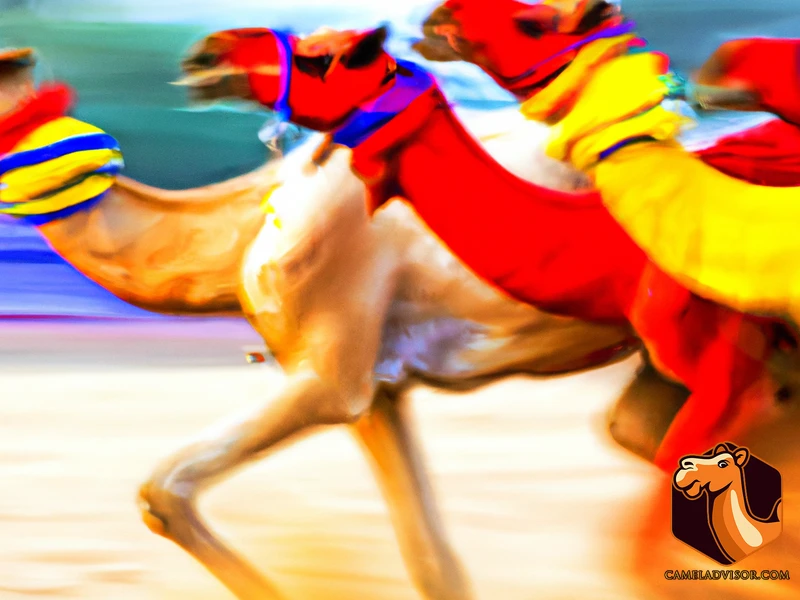
One of the essential gears that help to enhance the performance of racing camels is their leg wraps. These wraps are designed to provide adequate support and protection to the camel’s legs during the race.
The Function of Leg Wraps
Leg wraps also help to prevent their legs from getting injured as the camels move at high speed, covering long distances. These wraps offer support and stability to the delicate bones and tissues in the camel’s legs, which can easily get damaged or strained during the race.
Types of Leg Wraps
There are mainly two types of leg wraps used in professional camel racing: cloth wraps and bandage wraps. Cloth wraps are made of soft cotton, and they are wrapped around the camel’s legs in multiple layers to provide support and protection. Bandage wraps are more advanced and come with Velcro straps that make them easier to put on and take off.
The type of leg wrap used depends on the preference of the owner or trainer and the level of comfort it provides to the camel. Professional camel racers prefer bandage wraps since they offer better support and flexibility.
The Design of Leg Wraps
The design of the leg wraps has significantly evolved over the years. Initially, they were just plain white wraps that were wrapped around the camel’s legs indiscriminately. However, with technological advancements in the sport, leg wraps are now made to fit the legs of the camel precisely. They come in different colors and patterns, giving the sport a more aesthetic appeal.
The Importance of Leg Wraps
Leg wraps are crucial in camel racing since they help protect the camel’s legs and contribute to its overall performance. They prevent injuries, promote effective movement, and improve racing times.
Leg wraps are an essential component of professional camel racing. They provide support, protection, and enhance the overall performance of racing camels, making them an indispensable gear in the sport.
The Nose Clips and Ear Plugs
In professional camel racing, even small details can make a big difference. Nose clips and ear plugs are among the gears used by jockeys to maximize their camel’s performance.
Nose clips are used to increase airflow to the camel’s lungs during a race. The clips are small, lightweight devices that can be easily attached to the camel’s nostrils. By opening up the nostrils, the clips allow the camel to breathe more easily and take in more oxygen. This can help the camel maintain its speed and endurance during a race.
Ear plugs are used to protect the camel’s ears from loud noises during a race. Camels have a sensitive hearing and the loud and chaotic atmosphere of a racing arena can be stressful for them. Jockeys use ear plugs to block out the noise and create a calmer environment for their camel. This can help reduce stress and anxiety for the camel, and allow them to focus on the race ahead.
Both nose clips and ear plugs are not mandatory gears and their use is up to the jockey’s discretion. Some jockeys prefer not to use them, while others swear by them as important tools to give their camels an edge in the race.
It’s worth noting that the use of nose clips and ear plugs has raised some animal welfare concerns. Animal rights activists argue that these gears may cause discomfort or pain to the camels. However, many race organizers insist that the use of these gears doesn’t harm the camels and is necessary for their safety and well-being during a race.
In the end, whether or not to use nose clips and ear plugs is a decision that each jockey must make for themselves, taking into account the needs and well-being of their own camel.
The Whips
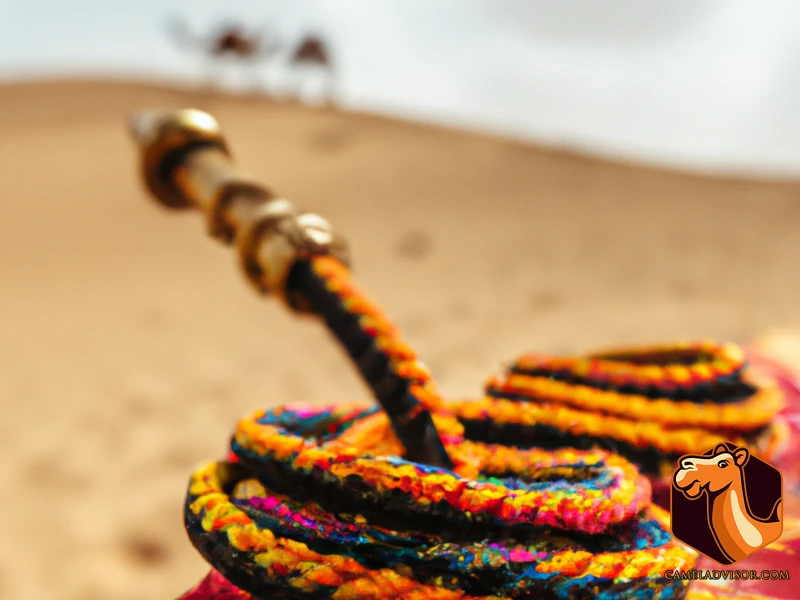
One controversial piece of gear used in professional camel racing is the whip. The use of whips in camel racing has long been a topic of debate, with some arguing that they are necessary for controlling the animal and others denouncing the practice as cruel and unnecessary.
Some jockeys believe that the whip is a necessary tool for encouraging their camels to run faster and maintain their pace during the course of the race. These whips are typically made of lightweight materials such as leather or synthetic materials, and feature a long handle with a small, stinging end.
However, opponents argue that the use of whips in camel racing is not only cruel, but also ineffective. Studies have shown that camels actually run faster and more efficiently when they are not being whipped, as the fear and stress caused by the whip can cause them to become unresponsive and stubborn.
In response to this controversy, some races have instituted rules and regulations around the use of whips. For example, in the United Arab Emirates’ Al Ain Camel Racing Festival, jockeys are not allowed to use whips during the race except in extreme cases where their safety may be compromised.
The use of whips in camel racing remains a contentious issue, and it is likely that we will continue to see debate around this piece of equipment in the years to come.
The Training Equipment
When it comes to professional camel racing, training is just as crucial as the gear used during the actual race. Trainers use a variety of innovative tools and equipment to prepare both the camels and their riders for the intensity of the competition. From mechanical camels to specialized treadmills, the training equipment used in camel racing is as fascinating as it is effective. Let’s take a closer look at some of these innovative tools that have revolutionized the sport.
The Mechanical Camels
The use of mechanical camels is a new and innovative approach to training camels for racing. These machines are designed to mimic the movements of live camels, making them an effective tool for both novice and experienced jockeys alike. Here are some details about this revolutionary gear:
- The Design: Mechanical camels are typically made of metal and have a saddle-like structure to sit on. They have a motorized system that moves the saddle up and down, creating a motion that simulates the movement of a live camel.
- The Benefits: The use of mechanical camels in training helps jockeys get accustomed to the motion and rhythm of riding a live camel. It also allows for controlled and consistent training sessions, whereas live camels may not always be available for training due to their resting period or other factors.
- The Training Programs: Some camel racing clubs have implemented training programs that use mechanical camels exclusively for young jockeys. This helps aspiring jockeys gain experience in a safe and controlled environment.
- The Challenges: While mechanical camels are ideal for training, they cannot replace live camels entirely. Jockeys still need to learn how to handle live camels and respond to their behaviors during a race.
The use of mechanical camels in training has proven to be a game-changer for camel racing. They provide a stable and controlled platform for jockeys to practice their skills and prepare for the challenges of live racing.
The Treadmills
Treadmills are an important part of the training regimen for professional camel racing. These machines are specifically designed to hone the racing skills of camels, and equip them with the physical stamina and agility required to excel in competitive racing. In this section, we will delve deeper into the role of treadmills in camel racing, and explore the features and benefits of these revolutionary training devices.
| Features | Benefits |
|---|---|
| Variable Speeds | The treadmill allows trainers to adjust the speed of the exercise according to the individual needs of the camel, enabling them to customize and optimize the workout experience for each animal, leading to greater physical conditioning and endurance. |
| Tracking Mechanism | Modern treadmills come equipped with tracking devices that monitor and record the performance of the camel. This enables trainers to track the progress of the animal, identify the areas that need improvement, and adjust the training accordingly. |
| Incline and Decline Adjustment | The treadmill allows trainers to adjust the incline and decline of the running surface, providing a more challenging workout and maximizing the muscle development and cardiovascular endurance of the camels. |
| Water Troughs and Fans | The latest treadmills come equipped with water troughs and fans that keep the camels hydrated and cool during the workout. This reduces heat stress and dehydration, keeping the camels healthy and improving their overall performance. |
| Reduced Risk of Injury | Treadmills provide a safer environment for training, reducing the risks of injuries that can happen while running on uneven terrain. Injuries are costly, time-consuming and stressful, and treadmills are a great option to minimize the risk of injuries during training. |
The treadmills used in training camels are designed to mimic the movements of running on a real track, while providing additional benefits of improved control, reduced risk of injury, and accurate tracking of progress. Trainers can easily monitor the speed and distance covered by the camel, and provide feedback in real-time, making it easier for the animals to improve their performance. The risk of injuries is also minimized, as the running surface is smooth and consistent, unlike the uneven surface of a race track. Treadmills are a valuable asset for trainers in the camel racing industry, and they play a pivotal role in the development of the racing skills of camels.
Conclusion
After exploring the various gears used in professional camel racing, one can’t help but be amazed by the level of sophistication and precision that goes into the sport. From the jockeys’ outfits to the training equipment, every gear used plays a crucial role in ensuring the success of the camel and its rider.
As spectators, we often only see the camels and their jockeys racing down the track at incredible speeds, but we fail to recognize the immense effort put in behind the scenes to make it all happen.
It’s fascinating to witness the evolution of traditional equipment to modern versions that are lighter and more efficient. The saddles, in particular, have undergone significant transformation to ensure the comfort and safety of the jockeys while racing.
The nose clips and earplugs are also an excellent example of how technology has helped to enhance performance and reduce stress levels for the camels during races.
Furthermore, the training equipment used in the sport, such as the mechanical camels and treadmills, showcase how cutting-edge technology is utilized to develop and enhance the skills of human and animal athletes in the sport.
Overall, professional camel racing is a unique and captivating sport that relies heavily on advanced gears and equipment for its success. It’s incredible to see how these gears have evolved over time to assist the camels and jockeys in achieving their goals. The attention to detail and precision involved in the sport is a testament to the love and passion that it commands. Indeed, for those who have witnessed it, professional camel racing is a sight to behold.
Frequently Asked Questions
What is camel racing?
Camel racing is a popular sport in Middle Eastern countries where camels race around a track, and the first camel to cross the finish line wins.
Why do jockeys wear certain gear when racing camels?
Jockeys wear gear to keep themselves safe and comfortable during the race, and to ensure that the camels perform at their best.
What are kanduras?
Kanduras are traditional long white garments worn by jockeys. They are made from lightweight fabrics and help to keep the jockeys cool in the hot weather.
What are safety jackets used for?
Safety jackets are worn by jockeys to protect them from injury in the event of a fall or collision during the race.
Why do jockeys wear caps?
Jockeys wear caps to protect their heads and faces from the sun and any flying debris that may be kicked up during the race.
What are traditional camel saddles made of?
Traditional camel saddles are made of wood and leather.
Why are some saddles lighter than others?
Lightweight saddles are used to reduce the weight that the camels have to carry during the race, which can help to improve their speed and performance.
What are blinkers used for?
Blinkers are used to help keep the camels focused on the track and prevent them from becoming distracted or spooked by their surroundings.
What are leg wraps used for?
Leg wraps are used to protect the camels’ legs from injury during the race.
What are nose clips and ear plugs used for?
Nose clips and ear plugs are used to help keep the camels calm during the race by reducing the amount of external stimuli that they are exposed to.

